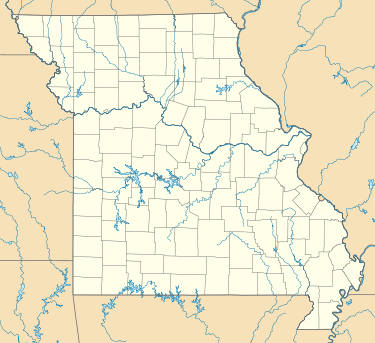Bluff Dweller's Cave
| Bluff Dweller's Cave | |
|---|---|
 | |
| Location | McDonald County, Missouri, United States |
| Coordinates | 36°31′08″N 94°29′13″W / 36.51883°N 94.48699°WCoordinates: 36°31′08″N 94°29′13″W / 36.51883°N 94.48699°W |
| Length | 3,268 feet (996 m) |
| Discovery | 1925 |
| Geology | Karst cave, Pierson Limestone/Saint Joe Limestone |
| Entrances | 2 |
| Access |
Open Winter Nov-Feb 10 am to 5 pm Spring/summer/fall Mar-Oct 10 am to 6 pm Closed Thanksgiving, Christmas Day & New Years Day |
| Features | 1 hour guided tour Browning Museum Gemstone Panning Giftshop |
| Website | www.bluffdwellerscave.com |
Bluff Dweller's Cave is a show cave located just south of Noel, Missouri that was discovered in 1925 and opened to the public in 1927. The cave was formed in the Pierson Limestone during the Paleozoic Era.[1] The cave's passages total over 4,000 ft in length, with two entrances beneath a limestone outcropping of the bluff.
Description
Bluff Dwellers Cave is formed in Mississippian age fossiliferous limestone. The Ozark Uplift raised the solid bed of limestone up above sea level where rainwater slowly seeped through cracks, dissolving away the water-soluble rock. Over time these cracks were enlarged enough that groundwater flowed through, creating the long passageways. The Ozark uplift continued, lifting the rock & cave within, above the water table, allowing the passageways to drain. Speleothems began to form as rainwater continued to dissolve the limestone over the cave and redeposit once it reached the open cave. The cave was accessed by prehistoric natives as a means of periodic shelter but was sealed off due collapse at the entrance before recorded history. Today Bluff Dwellers Cave is a beautiful show cave open to the public for an admission price.[1]
The cave was found in 1925 by C. Arthur Browning while checking traps on land he had lived his entire life. Browning found a small hole, about 1 foot in diameter, where cold air could be felt blowing out. He sought help to excavate the loose rocks and dirt so they could further explore the cave. During excavation, substantial artifacts were discovered, including arrowheads, grinding stones, tools made of bone and skeletal remains of the early Native American inhabitants, that date back to as early as 5000 B.C. Public tours began in 1927, and after over 90 years the cave is still owned and operated by the Browning family, today the 3rd generation.[2] Only 50% of the cave is developed for tours, the rest inaccessible to the public for preservation & safety reasons.
The cave has many speleothems including stalactites, stalagmites, cave coral, draperies, flowstone and rimstone. The crystal lake is created by a rimstone dam, which is 2.5 cm thick, 30 cm high and 22.8 meters long, is one of the largest in the state. Admission to the cave includes access to the Browning Museum where you can view arrowheads collected from the local area, rocks, minerals & fossils collected from around the country, and antiques from the Browning family.
The tour is led by a guide and takes approximately 1 hour. Some passageways are relatively narrow, allowing visitors to have an up-close & personal view of beautiful cave deposits. The walk is pretty easy going, only a few steps, but is narrow and low in some areas so it is NOT handicap accessible. The steps to get up to the cave entrance, gift shop and museum is the most strenuous parts of a visit. The cave is a constant 56 °F and is inhabited by bats, salamanders, crayfish and other small cave animals.
History
The Pierson Limestone was deposited during the Mississippian. Later in the Paleozoic the Ozark Uplift brought the rock above sea level, allowing fresh water to begin dissolving away the limestone to form the cave. Further uplift brought the cave above the water table and allowed abundant speleothems to form. The cave was accessed during Archaic times by Native Americans. At some point after the Archaic and before modern times the cave was sealed off by collapse. In 1925 Arthur Browning was exploring his land, checking traps, and discovered a small hole with cold air blowing out along a bluff. He soon enlisted the help of two surveyors employed by the highway department, Bob Ford and Bryan Gilmore, to excavate the rocks and debris blocking the entrance. During excavation, substantial artifacts were discovered, including arrowheads, grinding stones, tools made of bone and skeletal remains of the early Native American inhabitants,[3] that date back to as early as 5000 B.C. Arthur opened the cave to the public for tours in 1927. It is still owned and operated by the same family today, currently the 3rd generation, after 90 years of being open.[2]